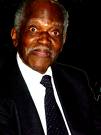main: June 2009 Archives
Please go to the center column and scroll down to Doug's Picks. There, you will find recommendations for two tenor saxophonists, a pianist who sings (or a singer who plays the piano), a pianist and a poet. Yes, a poet.
Ted O'Reilly writes from Toronto about the item in the following exhibit:
Nice stuff with the DBQ. I agree with your comments about the sound quality especially. It was in the days of Professionals when that was recorded: both musicians (who knew how to play together) and technicians. "Balance Engineers" who could listen to a group play, then simply(!) put THAT sound on the air, or disc usually capturing it with three or four well-placed microphones.
I am still in awe of the hundreds of performance airchecks I have by Ellington/Basie/Herman et al. which stand up so beautifully over decades. It sure is a differently-made beast that is presented to our ears these days...
Ted's communiqué put the Rifftides staff in mind of Roy DuNann's imperishable engineering for Contemporary Records. To read about him, see this archives piece.
YouTube has posted a few excerpts from programs the Dave Brubeck Quartet did for BBC television in 1964. The musical and the black and white video quality are superb. In the first one, I am struck by Brubeck's delicacy at the keyboard and by the fullness of Paul Desmond's alto saxophone sound. The critic Steve Race was the program host.
Race interviews Brubeck leading into a feature for bassist Eugene Wright. In the discussion, Brubeck earnestness and shyness are as noteworthy as Wright's playing. One other point: Desmond used to speak with enthusiasm about Brubeck's skill and sensitivity as an accompanist. In "The Wright Groove," Brubeck's comping behind Wright's solo is evidence of what Paul was talking about.
Up to my ears in curricular and non-curricular matters since my return from New York, I may or may not get around to writing more about last week's Jazz Journalists Association awards afternoon. In the meantime, Arnold Jay Smith posted a lively summary on Ted Gioia's jazz.com blog. In his lead paragraph, he alludes to the demise in the past few months of of several jazz magazines, including Jazz Times, Coda and Jazz Review.
In the face of what is fast becoming a debacle of biblical proportions for jazz, the Jazz Journalists Association held its 13th Annual Awards buffet at Jazz Standard on Tuesday, June 16. From all over the globe they came; scribes, radio and computer folks, business and professorial types, from the east, Midwest and western U.S., from across the pond, from up Scandinavia way, from down in the Caribbean, out of Africa, India, Russia and Kazakhstan. Proving once again that jazz is a multi-cultural, international language.
To read all of A.J.'s report, click here. The photo below shows Mr. Smith and Sharony Andrews preparing for the arrival of guests at the 2002 ceremony at the Jazz Standard. He was just as impeccably attired this year. His face, unfortunately, is mostly obscured by the brim of his chapeau, but his shoes are on full display.
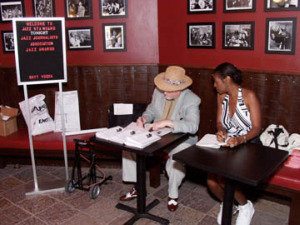
JJA President Howard Mandel's exhaustive report on the afternoon, generously illustrated with photographs, is in PDF form at this internet address.
Finally, as evidence that I really did show up this year, in this photo by JJA member 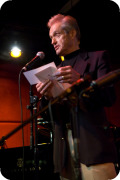 Steve Sussman, I am announcing that the 2009
Steve Sussman, I am announcing that the 2009  award for lifetime achievement in jazz journalism goes to Mike Zwerin (shown here on the left). Mike is most likely the only jazz writer of standing who doubles on bass trumpet and trombone. He was in the original Miles Davis-Gerry Mulligan-Gil Evans Birth of The Cool band. For decades, he has written from Paris with forthrightness, humor and the insights of a trained musician. Zwerin was unable to attend. His friend the novelist Rafi Zabor accepted for him.
award for lifetime achievement in jazz journalism goes to Mike Zwerin (shown here on the left). Mike is most likely the only jazz writer of standing who doubles on bass trumpet and trombone. He was in the original Miles Davis-Gerry Mulligan-Gil Evans Birth of The Cool band. For decades, he has written from Paris with forthrightness, humor and the insights of a trained musician. Zwerin was unable to attend. His friend the novelist Rafi Zabor accepted for him.
Each man reads his own meaning into New York. --Meyer Berger
One belongs to New York instantly, one belongs to it as much in five minutes as in five years. --Thomas WolfeI miss New York. I still love how people talk to you on the street - just assault you and tell you what they think of your jacket. --Madonna
I love short trips to New York; to me it is the finest three-day town on earth. --James Cameron
It is an ugly city, a dirty city. Its climate is a scandal. Its politics are used to frighten children. Its traffic is madness. Its competition is murderous. But there is one thing about it-once you have lived in New York and it has become your home, no other place is good enough. --John Steinbeck
At Grand Central Station, I plop into a chair in a semi-circle of what look like overstuffed maroon leather armchairs, a hard plop; the chair is molded plastic. One of New York's great free shows is underway in the lower concourse, with a cast of thousands. It's the evening commute to the northern suburbs. Many of the commuters are running. The picture doesn't do justice to the activity and energy of the place.

"Attention, please. The 5:36 express for Tarrytown, leaving on Track 6 in one minute."
A young woman runs by in Dolce and Gabbana jeans. I can tell that they are Dolce and Gabbana because a shiny silver badge on the waist band announces the fact. Hey, if you're going to wear 400-dollar pants, why keep it a secret? Her lower body is clad in high fashion and she looks great, but there's discomfort in her expression. Those tight jeans were meant for striking poses, not running. If she could afford 400 bucks for pants, she could take a limo to Scarsdale. One in five people (ratio not scientifically confirmed) is on a cell phone. Many of them are running.
"I just called to tell you I can't talk. I'm running for the train."
"I missed the 5:10. I'll be 20 minutes late. Pick me up. 'Bye. Gotta run."
An old woman in short grey hair, a boxy grey suit and mannish brown shoes walks by with a three-year-old boy by the hand. The boy's other hand is in the hand of a girl of about six. Surrounded by the streaming crowd, the children look bewildered, fearful. The woman is forging ahead, determined and grim. Grandmother? Governess? Kidnapper?
A number of the young women are wearing shower shoes, as they used to be known. Later, they were called zoris. Now, the acceptable term is flip-flops. As the girls run, the footwear neither flips nor flops. The sound is flap, flap, flap, flap, flap. I wonder if they wore those things all day at work or shopping in Manhattan. Wouldn't their feet get dirty? A drastically short woman in tight capri pants and four-inch heels speeds by. She has what my father used to call a hitch in her getalong, and her sound is clack, de-clack, clack, de-clack, echoing through the concourse.
Five people standing together at the top of the ramp in front of the Oyster Bar break into applause. I look for what inspired them. Nothing is evident, but they look delighted. It probably wasn't the extremely tall Hassidic gentleman strolling toward his track with dignity, a tall black hat and a briefcase the size of a small trunk. I wonder if he's from the diamond district, carrying a load of samples to a wealthy client in Bronxville.
A sign of the times: I see elderly men in suits--more than a dozen in a few minutes--clutching briefcases, wearing their weariness on their faces, slumping toward their trains. Did they expect still to be working at their ages, still catching trains?
A young man slips into the big maroon chair next to mine. His afro is stuffed into an enormous knit cap puffed into the shape of turban. His gold ear ring is fashioned to look like a small horseshoe. He eats a half-pint of yogurt or cottage cheese, then promptly falls asleep. His head slowly leans until it is parallel to his right shoulder. The clack de-clacking, flap-flapping, departure announcements and general hubbub do not interrupt his nap. As I leave, I hope he doesn't miss his train.
The woman to my left gets up at the same moment I do. I say to her, "It was a great show, wasn't it?" She looks startled, then laughs and says, "Yeah...if that's what you want to call it."
I do.
Rifftides Washington, DC, correspondent John Birchard attended last week's descent of several Marsalises on the nation's capital.
THE MARSALIS FAMILY GOES TO WASHINGTONBy John BirchardMonday, June 15th, 2009, was a day to remember in this capitol city. A jazz-loving First Family welcomed New Orleans' First Family of Jazz to 1600 Pennsylvania Avenue for an unprecedented session in jazz education. Veteran pianist and educator Ellis Marsalis and his musician sons Branford, Wynton, Delfeayo and Jason conducted workshops for 150 students aged 8 to 18 in three rooms of the White House, where they werewelcomed by First Lady Michele Obama. (The nation's Number One jazz fan was occupied elsewhere with health care reform. The President is pictured here with Wynton Marsalis at the White House in January.)
Following the workshops, the students gathered in the East Room for a short concert featuring Cuban saxophonist Pacquito D'Rivera and a teen-age combo. The events were held in conjunction with Washington's fifth annual Duke Ellington Jazz Festival and the Thelonious Monk Institute of Jazz, which paid for some of the students to travel to Washington.Among her comments, the first lady said, "There's no better example of democracy than a jazz ensemble - individual freedom, but with responsibility to the group." She noted that growing up in Chicago, jazz was always playing in her family's household.
As extraordinary as the day was, the celebration didn't end at the White House. Monday evening, the Marsalises convened at the Kennedy Center where, in the sold-out 2,400-seat Concert Hall, they were joined by Dr. Billy Taylor and another Crescent City product (and ex-Ellis Marsalis student) Harry Connick, Jr. in a salute to the family patriarch. Additional starters were bassist Eric Revis and drummer Herlin Riley.
Very rarely do the members of the Marsalis family appear on the same stage and Monday's concert gave them an opportunity to share their love and appreciation for the father who guided them all toward careers in jazz. One after the other, the sons offered anecdotes of their upbringing, laced with humor and respect. They kidded each other and they also made clear how much they love and appreciate their mother Dolores for her role in the family.Branford told the audience that the evening's program would be made up of tunes associated with various points in their father's career. The first came from when their father and mother were courting - Louis Jordan's "Choo Choo Ch-Boogie" done in suitably old-timey style. From the bebop era came "Donna Lee", featuring Wynton in a cup mute and Jason astonishing the audience with some expert whistling as he traded fours and eights with his older brother. Jason also showed impressive skill with the vibraphone on a later tune. Delfeayo got off some excellent work on trombone and Branford was expressive on tenor sax. Wynton remains an extraordinary trumpet player delivering several crisp and soulful solos during the evening.
The second half of the concert opened with twin pianos - Ellis Marsalis and Billy Taylor, doing "Body and Soul." The two senior citizens (Marsalis is approaching 75 and Dr. Taylor will soon be 88) may be a trifle bent with age, but they still can negotiate the keyboard. Then, Taylor departed to be replaced by Harry Connick, Jr., who joined Ellis for a funky reading of "Sweet Georgia Brown." Connick told of being a student of Marsalis, of hanging out at the Marsalis household and being picked on by Branford and Wynton. Connick then sang "Stardust" with his former teacher accompanying.
The "boys" came back on stage to round out the evening with one of Jason's compositions, a quirky stop-start melody underpinned by a distinctly New Orleans beat. The solos were rousing and the ensembles were tight, just as you would expect from such a gifted group. An ovation from the full house was warm and enthusiastic for Ellis Marsalis and his talented offspring. It was a happy end to a unique day in American musical history.
The Jazz Journalists Awards ceremony yesterday at the Jazz Standard on New York City's east side was more than three hours of jam-packed activity in a crowded club. The highlight of the afternoon was 90-year-old Hank Jones accepting the Pianist of the Year award. Beautifully dressed, erect, looking 20 years younger than his age and speaking prose as elegantly constructed as one of his solos, he said "This is encouragement to do better," and, "It's just the end of the beginning."
There is little of Mr. Jones's degree of class left in jazz. There is little of it in American life. "I'll see you at this event in 20 years," he said.
I hope that we are that fortunate.
For a complete rundown of the award winners and a marvelous photograph of Hank at the ceremony holding a photograph of Hank, please see the JJA web site by clicking here.
 I like New York in June. I'd like it more if we didn't have heavy rain, with more in the forecast. Umbrellas crowd the streets. People discussing the weather give that "Hey, whaddaya gonna do" New York shrug. Last night at the Tutuma Social Club, Gabriel Alegria and Laurandrea Leguia told me that in Lima, Peru, umbrellas are unknown because it never rains. Lima is their home town. They are New Yorkers now, making a name for their band, blending Peruvian and Caribbean influences with jazz to make music as subtle as the Peruvian food served at Tutuma. To see a Rifftides review of an Alegria concert, click here.
I like New York in June. I'd like it more if we didn't have heavy rain, with more in the forecast. Umbrellas crowd the streets. People discussing the weather give that "Hey, whaddaya gonna do" New York shrug. Last night at the Tutuma Social Club, Gabriel Alegria and Laurandrea Leguia told me that in Lima, Peru, umbrellas are unknown because it never rains. Lima is their home town. They are New Yorkers now, making a name for their band, blending Peruvian and Caribbean influences with jazz to make music as subtle as the Peruvian food served at Tutuma. To see a Rifftides review of an Alegria concert, click here.
The Tutuma is a new midtown restaurant and music club that one of its owners, Santina Matwey, told me is in a "soft opening" phase. Nonetheless, it seems to be fully operational, with not only a menu of the small individual servings of the delicacies known as tapas, but also a full-sized portion of music delivered by Lisa Harriton. Ms. Matwey and her husband visited Peru and fell in love with its people, music and cuisine. They came back to New York and, with Gabriel and Laura Alegria as advisors, applied their restaurant experience and skills to the creation of this happy little basement room on 56th Street just off Third avenue.
Lisa Harriton, with the Alegrias' rhythm section as collaborators, sang and played a set of songs in approximately the same trans-genre spirit as the music made by the Alegrias and, increasingly, by North American musicians including Maria Schneider, Geoffrey Keezer, Ingrid Jensen and Jon Wikan. Harriton's impeccable Spanish, her hip phrasing and her piano solos might come as a surprise to those who know her only for her work with the alternative rock band The Smashing Pumpkins. She studied at the University of Southern California with, among others, Shelly Berg and Alan Pasqua. After graduation, she took work with The Smashing Pumpkins because, as you may have heard, entry level gigs are hard to come by for young jazz musicians. The Pumpkins engagement has ended, probably bad fiscal news for her. For those who heard her last night, it was good listening news.
She studied at the University of Southern California with, among others, Shelly Berg and Alan Pasqua. After graduation, she took work with The Smashing Pumpkins because, as you may have heard, entry level gigs are hard to come by for young jazz musicians. The Pumpkins engagement has ended, probably bad fiscal news for her. For those who heard her last night, it was good listening news.
Tonight at Tutuma, the Alegrias will perform following a set by Harriton. I'm thinking of spending another of my precious New York nights there.
Later in the day, I'll try to post a little something about the Jazz Journalists Association and ASCAP Jazz Wall of Fame awards events that brought me to town.
Many thanks to Michael and Kaitlyn of Starbucks at 19th Street and Eighth Avenue for coming to my internet rescue and making this entry possible and to Starbucks for playing Miles Davis and Ella Fitzgerald while I wrote it. Additional thanks to my matronly cross-town bus driver. When my Metrocard popped up short half a dollar and I didn't have two quarters to drop in the box, she said, "You got a dollar? Let's see if we can get you some change. Anybody got change for a buck?"
"I do," said a women seated on one of the side seats. Fifty cents in the box and we were on our way east on 23rd Street. I profusely thanked the driver.
"I just wanted to help you, baby," she said.
I like New Yorkers in June.

Artsjournal.com unleashed Rifftides on the world four years ago today. A lot of blogging has gone down since then. See the archives (center column) for a complete history. Here's a section of the first item, posted June 15, 2005, when I was in New York promoting Take Five: The Public and Private Lives of Paul Desmond.
The Village Vanguard was sold out, full of advance planners and second mortgagers eager to hear Lou Donaldson. We wandered three blocks down the street and found a 1920s garage converted into a jazz club. Even adjusting for inflation, the Garage Restaurant at 7th Avenue South near Grove is no throwback to the last golden age of jazz in New York--not in the fiscal sense. A couple of drinks can make twenty dollars disappear. But there is no cover and no minimum, and it is possible even on a populous Saturday night to comandeer a stool at the bar, focus your hearing through the hilarity and be treated to a superior jazz performance.
We listened to the Nick Moran trio with bassist Marco Panascia and pianist Eduardo Withrington. Moran is a good young guitarist with a lyrical bebop bent and an alert harmonic faculty. He would benefit from self-editing, but it's a rare young improviser who would not. Unless you don't want to hear the piano, try for a spot at the bar that is not under the enormous copper air vent, a relic of a cooking area long dismantled. The metal seems to block or absorb the piano's sonority.Next up was the bright young tenor saxophonist Virginia Mayhew, a Garage regular. She was at the helm of a pianoless quartet, a good idea under the acoustic circumstances. Mayhew's playing was so far advanced from the last time I heard her that I was riveted by her expansive tenor sound, flow of ideas, humor, use of space, and swing that is by turns loping and hard-driving.
To read the whole thing, go here.
By coincidence, as you read this I am on my way to New York again, for a week of business and pleasure. I'll attend the Jazz Journalists Association awards at the Jazz Standard to present the JJA journalism lifetime achievement award to the 2009 winner. I was unable to be there last year to accept it. And, who knows, maybe I'll make it down to The Garage again. Blogging will be as time allows.
Thanks to Rifftides readers around the world for four years of interest, support and participation.
Onward.
Bill Kirchner alerts us to his latest Jazz From the Archives tonight on the radio and the internet.
Recently, I taped my next one-hour show for the "Jazz From The Archives" series. Presented by the Institute of Jazz Studies, the series runs every Sunday on WBGO-FM (88.3).
For over thirty years, reed player Gerry Niewood (1943-2009) was a mainstay of theNYC music scene. Not only was he a superb improviser (on soprano, alto, tenor, and baritone saxophones, flute, alto flute), but he was an always-reliable player in a variety of jazz and pop (Peggy Lee, Simon and Garfunkel, Judy Collins) situations. His life ended tragically when a plane he was aboard crashed near Buffalo, NY last February 12.
We'll hear Niewood, on all of his instruments, on recordings as a leader and as a sideman with fluegelhornist Chuck Mangione (with whom Niewood worked on and off for four decades) and trumpeter Randy Sandke.
The show will air this evening, June 14, from 11 p.m. to midnight, Eastern Daylight Time.
NOTE: If you live outside the New York City metropolitan area, WBGO also broadcasts on the Internet at www.wbgo.org.
To see a Rifftides piece on Gerry Niewood, click here.
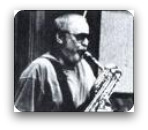 Sometimes fate does not distribute her gifts based on merit. Jack Nimitz never achieved the recognition, popularity or record sales of Gerry Mulligan, Pepper Adams or Serge Chaloff. Nonetheless, he was fully their peer as a baritone saxophonist of the post-bop era. Nimitz died last Wedneday in Los Angeles at the age of 79. From the early 1950s in Washington, DC, with The Orchestra, through the bands of Bob Astor, Johnny Bothwell, Woody Herman and Stan Kenton, Nimitz was a sturdy anchor of reed sections and a soloist of power and creativity.
Sometimes fate does not distribute her gifts based on merit. Jack Nimitz never achieved the recognition, popularity or record sales of Gerry Mulligan, Pepper Adams or Serge Chaloff. Nonetheless, he was fully their peer as a baritone saxophonist of the post-bop era. Nimitz died last Wedneday in Los Angeles at the age of 79. From the early 1950s in Washington, DC, with The Orchestra, through the bands of Bob Astor, Johnny Bothwell, Woody Herman and Stan Kenton, Nimitz was a sturdy anchor of reed sections and a soloist of power and creativity.
After he moved to Los Angeles in the early sixties, Nimitz was a first-call baritone player in studios and on a dozen or more big bands, including those of Benny Carter, Gerald Wilson, Terry Gibbs, Oliver Nelson and Frank Capp. He was a charter member of Supersax, the saxophone band that specialized in orchestrated Charlie Parker solos. Nimitz is on scores of other peoples' albums, but did not release a CD as a leader until 1995 with Confirmation. That recording is out of print or, as the record company's web site optimistically announces, "temporarily out of stock."
Fortunately, his second CD, Yesterday and Today, is available. It teamed Nimitz with another neglected master, the trombonist Bill Harris and, five decades later, with a rising young player of Nimitz's own instrument. From a 2008 Rifftides review:
Jack Nimitz, Yesterday And Today (Fresh Sound). "Yesterday" was 1957, when the distinctive baritone saxophonist recorded a long-playing album for ABC-Paramount. The LP sat unissued for half a century. "Today" was early last year, when Nimitz went into the studio to record new music to add to the 1957 material and round out a compact disc. Nimitz's tone has more heft and his soloing more aggressiveness than fifty years ago. In both instances, his playing is superb.
To read the whole thing go here.
Funeral services are scheduled for Saturday, June 20, at the Church of the Hills, Forest Lawn Cemetery, in Los Angeles.
 If you have read Poodie James, you may remember Winifred Stone. She is the publisher of the newspaper that was important to the development of Poodie's town by the Columbia River and the agricultural region around it. In the story, she is concerned about Poodie's persecution by the mayor. Her paper is important in exposing that injustice. Her character is based on a real person and her newspaper on a real publication. This week, National Public Radio's StoryCorps was in Wenatchee, Washington, on its mission of capturing tales told by interesting people. In the StoryCorps interview, Wilfred Woods, the publisher son of that publisher, told his father's story. Yes, father. In the book, I made the publisher a woman. It's fiction. That sort of thing is allowed.
If you have read Poodie James, you may remember Winifred Stone. She is the publisher of the newspaper that was important to the development of Poodie's town by the Columbia River and the agricultural region around it. In the story, she is concerned about Poodie's persecution by the mayor. Her paper is important in exposing that injustice. Her character is based on a real person and her newspaper on a real publication. This week, National Public Radio's StoryCorps was in Wenatchee, Washington, on its mission of capturing tales told by interesting people. In the StoryCorps interview, Wilfred Woods, the publisher son of that publisher, told his father's story. Yes, father. In the book, I made the publisher a woman. It's fiction. That sort of thing is allowed.
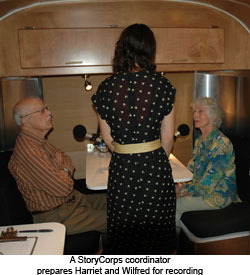
The StoryCorps folks recorded Mr Woods in conversation with Harriett Bullitt, another vital figure in North Central Washington. What they didn't explain in the setup is that in addition to her founding of the famous Sleeping Lady Mountain Resort, Ms. Bullitt is a member of a family that pioneered radio and television broadcasting in the Pacific Northwest. She asked Wilfred Woods to talk about his dad, Rufus, who gets a significant portion of the credit for the existence of Grand Coulee Dam. That depression-era achievement made irrigation possible and brought prosperity to an area that was turning to dust.
To hear the conversation as it ran on Northwest Public Radio and see its accompanying slide show, click here.
I am happy to report that Poodie James is still the publisher's best seller.
Here is Wayne Shorter at France's splendid Vienne Festival in 2003. The other members of his quartet are pianist Danilo Perez, bassist John Patitucci and drummer Brian Blade.
Added attraction: the wide shots of Vienne's ancient Roman amphitheater.
Stan Kenton could be grandiose in his music. Otherwise, for the most part, he was down to earth. In the 1950s following a concert, a reporter asked him, "Mr. Kenton, where is jazz going from here?"
to earth. In the 1950s following a concert, a reporter asked him, "Mr. Kenton, where is jazz going from here?"
"Well," Kenton said, "tomorrow night we'll be in Detroit."
That is still the best response I've found to a question that will continue to be asked and can never be answered. Atlantic Records called Ornette Coleman's first album for that label The Shape Of Jazz To Come. A more honest title, it turned out, was that of his final Contemporary album a few months earlier: Tomorrow Is The Question. Coleman has influenced certain aspects of jazz over the past half-century, but he has not shaped it. Charlie Parker and Dizzy Gillespie had enormous effect on the course of the music, but in 1943 it would have been impossible to predict that their innovations would reach so far. It is orthodoxy for jazz historians and critics to declare that in 1928 Louis Armstrong's "West End Blues" was the turning point into a new jazz maturity, but that is with the perspicacity of hindsight.
Tomorrow will always be the question, so when we listen to adventurous new music, it might be safest to judge it on its merits rather than proclaim it a vision of the future. Here are reviews of recent CDs by artists who are interesting but may not be messiahs. Who knows where they're headed?
Detroit, perhaps.
 Miles Okazaki, Generations (Sunnyside). Okazaki is a composer who closely controls his concepts while allowing his soloists enough latitude that the music has spontaneity. His guitar solos are well executed, but in the nine sections of this continuous work, three alto saxophonists and a vocalist dominate the sound. Miguel Zenón, David Binney, and Christof Knoche comprise a saxophone choir in several segments. There is enough similarity in their approaches that unless you are familiar with their subtleties, it will be helpful to refer to the booklet credits to see who is soloing at any given moment. All of them are satisfying, but on "Generations," Zenon reaches a high point, escalating power and passion, then subsiding into peacefulness.
Miles Okazaki, Generations (Sunnyside). Okazaki is a composer who closely controls his concepts while allowing his soloists enough latitude that the music has spontaneity. His guitar solos are well executed, but in the nine sections of this continuous work, three alto saxophonists and a vocalist dominate the sound. Miguel Zenón, David Binney, and Christof Knoche comprise a saxophone choir in several segments. There is enough similarity in their approaches that unless you are familiar with their subtleties, it will be helpful to refer to the booklet credits to see who is soloing at any given moment. All of them are satisfying, but on "Generations," Zenon reaches a high point, escalating power and passion, then subsiding into peacefulness.
Jen Shyu's soprano voice rides on top of the ensemble, sometimes in counterpoint, sometimes in unison with one or more instruments--including drums. Bassist Jon Flaugher, drummer Dan Weiss and Okazaki are the rhythm section, swinging forthrightly in places, controlling the expansion and contraction of time in "Overture" and elsewhere. Okazaki's web site includes the score for "Generations." You needn't be an accomplished sight reader to see the meticulousness with which he prepares his music. He achieves an expansiveness that can be restful even when there's agitation below the surface of the music. And he's one young jazz artist who knows the value of dynamic contrast.
Jacám Manricks, Labrynth (Manricks Music). An Australian who moved to New York nearly ten years ago, Manricks plays saxophones, flutes, clarinet and bass clarinet. Like Okazaki, his writing is as important to his music as his playing. He proves it here by employing not only a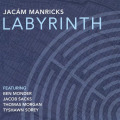 quintet but also, on two tracks, a ten-piece chamber orchestra. In his album notes, Manricks acknowledges the influence of Debussy, Schoenberg, Gil Evans and Ravel, and although they are detectable, Manricks' originality is more in evidence. His strings ensembles float the listener through "Micro-Gravity." His harmonic voicings, uses of powerful rhythms and the electronically manipulated textures of Ben Monder's guitar are among the elements that make "March And Combat" gripping listening. Conceptual writing also rules the combo tracks, each of which contains plenty of stimulating soloing by Manricks, Monder, pianist Jacob Sacks, bassist Thomas Morgan and drummer Tyshawn Sorey. This one came out of the blue. I'm glad that it did.
quintet but also, on two tracks, a ten-piece chamber orchestra. In his album notes, Manricks acknowledges the influence of Debussy, Schoenberg, Gil Evans and Ravel, and although they are detectable, Manricks' originality is more in evidence. His strings ensembles float the listener through "Micro-Gravity." His harmonic voicings, uses of powerful rhythms and the electronically manipulated textures of Ben Monder's guitar are among the elements that make "March And Combat" gripping listening. Conceptual writing also rules the combo tracks, each of which contains plenty of stimulating soloing by Manricks, Monder, pianist Jacob Sacks, bassist Thomas Morgan and drummer Tyshawn Sorey. This one came out of the blue. I'm glad that it did.
Josh Berman, Old Idea (Delmark). There is a good deal of whimsy in cornetist Berman's quintet. Whimsy seems to go with avant garde territory in Chicago, the land of Ken Vandermark  and Rob Mazurek, not to mention the AACM. There are moments when he's not gliding through a melody that tenor saxophonist Keefe Jackson sounds as if he could be slap-tonguing and making animal sounds with a New Orleans band of the 1920s. Berman is not averse to spitting, whinnying and snorting with his horn. But there are moments of touching lyricism, as in the reflective "Nori" and the three versions of "Next Year." The band's approach reminds me of Tommy Peltier's Jazz Corps, which in 1966 made one memorable album that featured Roland Kirk. However far outside he may go in his improvised lines, Berman gets an old-timey sound like Peltier's on cornet. The band's spirit is often similar to the Jazz Corps, even unto the resemblance of the vibraphone playing of Berman's Jason Adasiewicz to that of Peltier's Lynn Blessing. Anton Hatwich is the bassist, Nori Tanaka the drummer. This is a fresh Old Idea.
and Rob Mazurek, not to mention the AACM. There are moments when he's not gliding through a melody that tenor saxophonist Keefe Jackson sounds as if he could be slap-tonguing and making animal sounds with a New Orleans band of the 1920s. Berman is not averse to spitting, whinnying and snorting with his horn. But there are moments of touching lyricism, as in the reflective "Nori" and the three versions of "Next Year." The band's approach reminds me of Tommy Peltier's Jazz Corps, which in 1966 made one memorable album that featured Roland Kirk. However far outside he may go in his improvised lines, Berman gets an old-timey sound like Peltier's on cornet. The band's spirit is often similar to the Jazz Corps, even unto the resemblance of the vibraphone playing of Berman's Jason Adasiewicz to that of Peltier's Lynn Blessing. Anton Hatwich is the bassist, Nori Tanaka the drummer. This is a fresh Old Idea.
Andrea Fultz, The German Projekt (Andrea Fultz). As we pointed out a couple of years ago, Louis Armstrong made "Mack The Knife" a jazz standard, but few jazz artists have explored Kurt Weill's songs of satire, outrage and beauty from The Threepenny Opera, Happy End and Mahagonny. For a Rifftides discussion of exceptions, go here. Now, we can add Andrea Fultz's new collection. Her 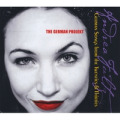 singing is knowing, sly, in tune, and gutsy. The daughter of a German mother and an American father, she sings these songs from the twenties and thirties in German, with only occasional side trips into English. She renders German so persuasively that by the end of my first hearing of the album I was nearly convinced that I understood the language. Whether or not she is one, she has the phrasing and inflections of a trained actress.
singing is knowing, sly, in tune, and gutsy. The daughter of a German mother and an American father, she sings these songs from the twenties and thirties in German, with only occasional side trips into English. She renders German so persuasively that by the end of my first hearing of the album I was nearly convinced that I understood the language. Whether or not she is one, she has the phrasing and inflections of a trained actress.
Seven of the songs are by Weill and his partner Bertholt Brecht, four by Friedrich Hollaender, another major figure in German musical theatre between the world wars. The repertoire includes "Alabama Song," "Bilbao Song," "Mackie Messer Moritat" ("Mack The Knife"),Hollaender's "Falling In Love Again" and the devastating anti-fascist "Song of a German Mother" by Brecht and Hanns Eisler. Fultz's accompaniment is by a hip young band of San Franciscans (piano, violin, accordian, bass and percussion). Much of this is heavy stuff, musically and emotionally, from a period when Germany was awash in forebodings of evil, and cynicism thrived. Thanks to the quintet's sensitivity to the music and the canny arrangements by accordianist Rob Reich, they manage to meld a German cabaret sensibility with a twenty-first century grasp of jazz feeling. The songs are riveting. This is my first encounter with Ms. Fultz. I'm looking forward to the next and hoping that she will be a part of the future of jazz.
Towner Galaher, Courageous Hearts (Towner Galaher). Galaher has been in New York for a couple of  decades, a ubiquitous drummer reliable and adaptable enough to be in demand by artists in a range from Louis Armstrong's former bassist Arvell Shaw to comparative youngsters like Jon Faddis, Wynton Marsalis and Arturo O' Farrill. For his second CD as a leader, composer and arranger, Galaher recruited a formidable band of veterans; trumpeter Brian Lynch, trombonist Fred Wesley, tenor saxophonist Craig Handy, pianist George Colligan, bassist Charles Fambrough and on the four Latin pieces, percussionists Gabriel Machado and Ze Mauricio. His compositions are in the middle of the modern mainstream, but with unexpected harmonic and rhythmic twists. Galaher's reworkings of Tadd Dameron's "Hot House" and Mongo Santamaria's "Afro Blue" are ingenious. So, too, are his drum fills behind soloists. He assembled the band just for this date; they had never played together as a group. That and adventurous soloing are the the only senses in which this music is experimental. They sound as if they had worked together for weeks. This may not be where jazz is headed, but if it were, I could live with it.
decades, a ubiquitous drummer reliable and adaptable enough to be in demand by artists in a range from Louis Armstrong's former bassist Arvell Shaw to comparative youngsters like Jon Faddis, Wynton Marsalis and Arturo O' Farrill. For his second CD as a leader, composer and arranger, Galaher recruited a formidable band of veterans; trumpeter Brian Lynch, trombonist Fred Wesley, tenor saxophonist Craig Handy, pianist George Colligan, bassist Charles Fambrough and on the four Latin pieces, percussionists Gabriel Machado and Ze Mauricio. His compositions are in the middle of the modern mainstream, but with unexpected harmonic and rhythmic twists. Galaher's reworkings of Tadd Dameron's "Hot House" and Mongo Santamaria's "Afro Blue" are ingenious. So, too, are his drum fills behind soloists. He assembled the band just for this date; they had never played together as a group. That and adventurous soloing are the the only senses in which this music is experimental. They sound as if they had worked together for weeks. This may not be where jazz is headed, but if it were, I could live with it.
 Rifftides reader Russ Mitchell asks:
Rifftides reader Russ Mitchell asks:
Is there ONE place to find ALL of Doug's picks? If there is, I can't find it.
They are archived. Follow these (relatively) simple directions:
1. Click on the Archives link in the center column, just below Doug's Books.
2. Scroll 'way down to the heading, Category Monthly Archives.
3. Scroll down past the list of months to the beginning of the recommendations listings. Click on individual months to see the picks. These go back to June of 2006.
For picks and reviews from June, 2005 through May, 2006, you can explore the month-by-month archive.
The following announcement is posted on the JazzTimes web site:
Important Message From JazzTimes Management By JazzTimes
To our readers and members of the jazz community:JazzTimes has temporarily suspended publication of the magazine and has furloughed the bulk of its staff while it finalizes a sale of its assets. The brand and operation will undergo reorganization and restructuring in order to remain competitive in the current media climate. Print publishing is expected to resume as soon as a sale is closed. New information and statements will be posted at www.jazztimes.com as they become available.
Thank you for your patience during this challenging period.
JazzTimes Management
With the suspension last year of the Canadian magazine Coda, the absorption of Britain's Jazz Review by Jazz Journal and the conversion of JazzIz to a quarterly, jazz listeners' choices of major print information about the music are disappearing fast. The question, unanswerable at this point, is whether web sites and blogs can provide the same depth and width of coverage generations have received from jazz magazines. This is a small manifestation of the larger challenge facing free societies as newspapers shrink or disappear. A democracy can only suffer from diminution and fragmentation of the flow of information upon which we base our judgments.
Let us hope that JazzTimes survives its reorganization. More important, let us hope that we do not lose news organizations serving mass audiences. They help bind us together.
There is still no confirmation, and no denial, of reports that Jazz Times will go out of business as a print publication. General economic decline, the increasing loss of advertising life blood and the necessity to shrink staffs weaken all magazines and newspapers.
Nasty fiscal weather is even more threatening to publications that specialize in cultural affairs. In hard times, support for the arts is likely to top the list of cuts in advertiser, donor and personal budgets. In his blog's Sunday Wax Bits, Marc Myers takes a perceptive look at the Jazz Times predicament and at alternatives to paper-based jazz information.
I don't buy the argument that the slow demise of print is tied to the "dumbing down of America." Fans today aren't reading less about jazz. They're just gravitating toward more essential content. What is essential? Content that's timely, surprising and independent. Sadly, many jazz magazines in recent years have missed the mark on all three fronts with cost escalations, talent drains and advertiser synergy deals.
To read the whole thing, go to JazzWax
Unconfirmed reports continue to filter out of Silver Spring, Maryland, that Jazz Times magazine's precarious advertising revenue position will force it to cease publication. In his latest post on the matter, my artsjournal.com colleague Howard Mandel quotes a recently dismissed Jazz Times associate editor as saying that "it's doubtful the magazine would be able to survive in its present format." To read Howard's posts on the situation, go here.
Ira Sabin founded Radio Free Jazz in 1970 as an adjunct to his retail record business. I began contributing reviews and articles in 1975 when it was printed on newsprint in a tabloid format. I have no clear notion of how many hundred thousand words I published there before and after it morphed into the slick magazine that became Jazz Times, gave Down Beat a run for its money and consistenty won awards. For a variety of reasons, I haven't contributed to Jazz Times in the past year or so, but if it disappears I will be saddened by a major loss to the community of listeners who value the music. I hope that efforts to save the magazine succeed.
The story about Dave Pell's restoration of Lester Young's Dolnet tenor saxophone brought a message from documentary producer Ken Koenig and one from Jim Harrod, moderator of the Jazz West Coast listserve. Each of their responses took the form of a photograph.
Mr. Harrod sent a copy of a Dolnet ad from an early-1950s issue of the magazine Jazz Hot.
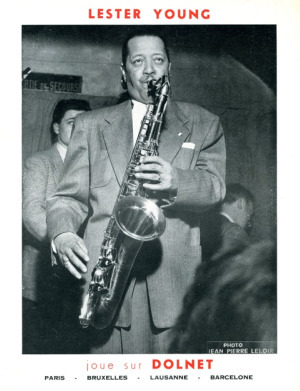
Mr. Koenig took a photograph of Dave Pell with the resuscitated Dolnet, and Lester in the background, at the Los Angeles Jazz Institute's A Swingin' Affair festival over Memorial Day weekend. The most cursory examination of Mr. Pell's head in comparison with his photo at the bottom of the previous exhibit will disclose that more than the saxophone has been restored.
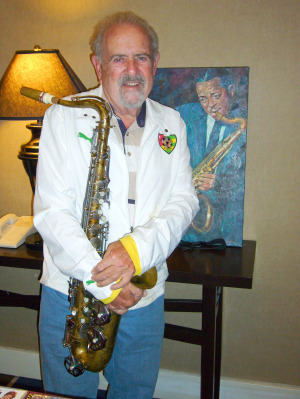
The Rifftides staff thanks Mr. Harrod and Mr. Koenig.
The following article appeared in the Fall, 2008, issue of the British magazine, Jazz Review.
Lester Young drew on Louis Armstrong, Frank Trumbauer, Bix Beiderbecke and his own genius to create one of the most personal styles in music. In the 1930s he provided an evolutionary step between Armstrong and Charlie Parker. Flying weightlessly over bar lines, Young helped to free the jazz soloist from the arbitrary restrictions of time divisions and showed the way to the rhythmic and harmonic foundations of bebop. He became a hero of forward-looking musicians of several decades. Billie Holiday, his friend and musical alter-ego, called him the president of tenor saxophonists. His nickname became Prez.
More than seventy years after his first recordings with Count Basie, Young's buoyancy, harmonic subtlety, flexibility with rhythm and distinctive tonal qualities keep his playing alive and fresh. Time has been less kind to one of the tenor saxophones that Prez used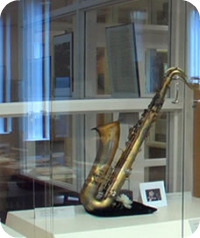 to make his music. In the course of his career, his main horn was the Conn he played with Basie. His second was a tenor presented to him in the 1950s in France by the Dolnet company, which had made reed instruments since 1888. He played it in the few years before he died.
to make his music. In the course of his career, his main horn was the Conn he played with Basie. His second was a tenor presented to him in the 1950s in France by the Dolnet company, which had made reed instruments since 1888. He played it in the few years before he died.
The Conn is enshrined in the Institute of Jazz Studies at Rutgers University in Newark, New Jersey, side by side with Billie Holiday's artificial gardenia and a certificate of authenticity signed by Young.
TO WHOM IT MAY CONCERN:This Conn saxophone, number 444,4444, is the saxophone I used with the Count Basie band in 1936 and later. With this horn I recorded "Twelfth St. Rag," "Song of the Islands," "Lester Leaps In," and "One O'Clock Jump"--among other numbers.
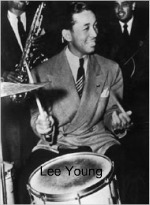 Young's Dolnet tenor sax fared less well.
Young's Dolnet tenor sax fared less well.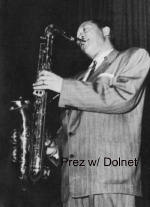 Following his lonely death at forty-nine in 1959 from the effects of alcoholism, the horn went to his younger brother Lee, successful in Los Angeles as a drummer, studio musician and music director for Nat King Cole. Lee Young consigned the horn to his basement, where it remained until after he died on July 31, 2008, at the age of ninety-one.
Following his lonely death at forty-nine in 1959 from the effects of alcoholism, the horn went to his younger brother Lee, successful in Los Angeles as a drummer, studio musician and music director for Nat King Cole. Lee Young consigned the horn to his basement, where it remained until after he died on July 31, 2008, at the age of ninety-one.
Among Lee Young's friends in the L.A. music community was Dave Pell, one of a legion of tenor players idolizing Lester and patterning their playing on his. Like Stan Getz, Zoot Sims, Frank Wess, Al Cohn, Brew Moore, Alan Eager, Paul Quinichette and dozens of other tenor players, Pell emulated Lester's tone, harmonic approach and melodic concept in improvisation. In the early 1950s he formed the Dave Pell Octet, recruiting as sidemen fellow members of Les Brown's popular dance band. The Brown band had jazz leanings that Pell expanded in the octet. As west coast jazz was on the rise, Pell's group blazed no trails but recorded a substantial series of albums with excellent playing by the Brown troops, including superb solo work by the trumpeter Don Fagerquist and plenty of solos by Pell. Other Los Angeles musicians who appeared on the octet's albums over the decade included Art Pepper, Jack Sheldon, Bob Gordon, André Previn, Pepper Adams, Mel Lewis and Bob Enevoldsen. Shorty Rogers Bill Holman and Jerry Fielding contributed to the band's book.
Through the 1960s and '70s, Pell worked as a musician in the Hollywood studios and as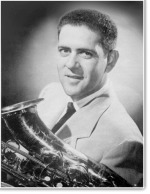 a producer who oversaw the recording of more than 400 albums. In 1978, his love for Lester Young resurfaced in the form of a band devoted to his hero's music. He called it Prez Conference, after a piece that Holman had written for the Stan Kenton band. The group recorded two albums for GNP Records. One featured Joe Williams singing songs that Young recorded. Pell, two other tenors and a baritone saxophonist played classic Prez solos on the pieces, orchestrated by Holman for the four horns.The other long-playing record had the same approach, without Williams but with trumpet solos by Young's Basie band mate Harry "Sweets" Edison. The albums sold well. The band appeared at the 1979 Monterey Jazz Festival and played on a package tour of Japan with the Modern Jazz Quartet and the Hi-Los. Fifteen tracks from the two albums are reissued on a GNP CD, Prez And Joe.
a producer who oversaw the recording of more than 400 albums. In 1978, his love for Lester Young resurfaced in the form of a band devoted to his hero's music. He called it Prez Conference, after a piece that Holman had written for the Stan Kenton band. The group recorded two albums for GNP Records. One featured Joe Williams singing songs that Young recorded. Pell, two other tenors and a baritone saxophonist played classic Prez solos on the pieces, orchestrated by Holman for the four horns.The other long-playing record had the same approach, without Williams but with trumpet solos by Young's Basie band mate Harry "Sweets" Edison. The albums sold well. The band appeared at the 1979 Monterey Jazz Festival and played on a package tour of Japan with the Modern Jazz Quartet and the Hi-Los. Fifteen tracks from the two albums are reissued on a GNP CD, Prez And Joe.
Pell's friend and golfing buddy Lee Young followed Prez Conference' progress, attended its performances in the L.A. area and occasionally sat in for its drummer, Frank Capp.
Pell, now eighty-three, recalled, "We had a regular golf game with Lee, his son Junior, and a bass player we found named Ray Brown, who was a golf nut, too. We'd play a foursome every Friday morning. I couldn't play as well as these guys, but I'd go along just to hear the Lester Young stories. Lee would always say, 'You know, I'd love to give you the horn.' I'd say, 'Well, give it to me.' And he'd say, 'I can't. Lester's children want the horn. They want to put it in a museum'
"When Lee died, Lee, Jr., called me and said, 'Come and get the horn.' Lee willed it to me, but when I die it goes back to the Young family. They're okay with that. They know it should be played. And I'm going to learn to play it, no matter how badly it behaves."
That presented a challenge. When Pell got the horn, he was shocked at what more than a half-century of basement damp had done to it.
"It had fifty-six years of rust," he said. "I took the thing home, and I said, 'Gee, maybe I can play the mouthpiece.' The mouthpiece plays just sensational. Just perfect. It sounds like Prez," he laughed.
Pell took the Dolnet to Steve Smith, a saxophone technician at United Band Instrument Company in Los Angeles, hoping to have it back in time to play it at a Prez Conference revival concert at the San Jose Jazz Festival in August (of 2008).
"Steve looked at me and said, 'You won't get this back for two or three months.' The rust on the horn itself comes off easy. You just dip it in solvent and all the rust disappears. But where the screws go in the sockets, it's another matter. When I called him after one week and said, 'How's it going?' he said, 'I've done six screws.' So, it's really going to be a project."
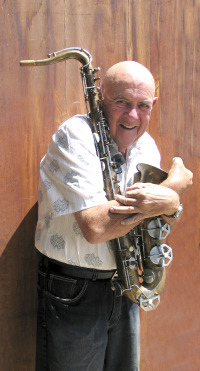 Pell used Lester's mouthpiece at the San Jose Festival. "All the saxophone players there came over and asked if they could touch it," he said with a smile. For the occasion, Prez Conference included its original drummer, Frank Capp; the young Los Angeles pianist John Proulx; bassist John Shifflet; and three northern California saxophonists, Kris Strom and Matt Kesner on tenor and Aaron Lington on baritone. They played the Holman arrangements, with coloratura soprano Bonnie Bowden on some pieces doubling the lead parts an octave higher. Pell says that he, the band and the audience were delighted with the success of the concert.
Pell used Lester's mouthpiece at the San Jose Festival. "All the saxophone players there came over and asked if they could touch it," he said with a smile. For the occasion, Prez Conference included its original drummer, Frank Capp; the young Los Angeles pianist John Proulx; bassist John Shifflet; and three northern California saxophonists, Kris Strom and Matt Kesner on tenor and Aaron Lington on baritone. They played the Holman arrangements, with coloratura soprano Bonnie Bowden on some pieces doubling the lead parts an octave higher. Pell says that he, the band and the audience were delighted with the success of the concert.
The rebirth of Lester Young's horn has inspired a new phase in the career of his octogenarian disciple. When Prez's Dolnet tenor is back in commission, Pell plans to record it in a new CD with the reconstituted Prez Conference and take the band on the road.
(Only the photo of Lester Young's Conn tenor saxophone appeared in the Jazz Review article.)
Everything is fine with the horn..play it everyday...recording a new CD, and it records sensationally, with Johnny Vana. Did a concert tonight in Palm Desert with Med Flory and Don Shelton..and we sounded just like 3 brothers.
Am booked at Sweet and Hot Festival with my tribute to Lester Young in August with Bonnie Bowden singing Billy Holiday songs and Prez Conference. It was kinda hard trying to make friends with the horn because of the problems of 56 years of rust. However it sounds so good,and I love it,
For a project connected with his Jazz At The Philharmonic operation, the impresario Norman Granz filmed Lester Young with trombonist Bill Harris, Pianist Hank Jones, bassist Ray Brown and drummer Buddy Rich. Although they bypass the melody, the piece is "Pennies From Heaven." For decades, there has been speculation, but no proof, that because of technical audio requirements, they are lip-synching to a performance they previously recorded. That could account for the general amusement and for a couple of what seem to be slight deviations of the sound from the picture.
AJ Ads
AJ Blogs
AJBlogCentral | rssculture
Terry Teachout on the arts in New York City
Andrew Taylor on the business of arts & culture
rock culture approximately
Laura Collins-Hughes on arts, culture and coverage
Richard Kessler on arts education
Douglas McLennan's blog
Dalouge Smith advocates for the Arts
Art from the American Outback
Chloe Veltman on how culture will save the world
For immediate release: the arts are marketable
No genre is the new genre
David Jays on theatre and dance
Paul Levy measures the Angles
Judith H. Dobrzynski on Culture
John Rockwell on the arts
innovations and impediments in not-for-profit arts
Jan Herman - arts, media & culture with 'tude
dance
Apollinaire Scherr talks about dance
Tobi Tobias on dance et al...
jazz
Howard Mandel's freelance Urban Improvisation
Focus on New Orleans. Jazz and Other Sounds
Doug Ramsey on Jazz and other matters...
media
Jeff Weinstein's Cultural Mixology
Martha Bayles on Film...
classical music
Fresh ideas on building arts communities
Greg Sandow performs a book-in-progress
Harvey Sachs on music, and various digressions
Bruce Brubaker on all things Piano
Kyle Gann on music after the fact
Greg Sandow on the future of Classical Music
Norman Lebrecht on Shifting Sound Worlds
Joe Horowitz on music
publishing
Jerome Weeks on Books
Scott McLemee on books, ideas & trash-culture ephemera
theatre
Wendy Rosenfield: covering drama, onstage and off
visual
Public Art, Public Space
Regina Hackett takes her Art To Go
John Perreault's art diary
Lee Rosenbaum's Cultural Commentary
